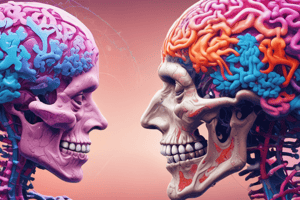Podcast
Questions and Answers
Which genetic factor is primarily linked to late onset Alzheimer disease?
Which genetic factor is primarily linked to late onset Alzheimer disease?
- Down syndrome
- Amyloid precursor protein
- Chromosomal alterations
- APOE genotype (correct)
What is the percentage of AD occurrences at a young age?
What is the percentage of AD occurrences at a young age?
- Less than 1% (correct)
- Around 5%
- Exactly 10%
- More than 20%
Which of the following is NOT listed as an AD risk factor?
Which of the following is NOT listed as an AD risk factor?
- Head injury
- Cancer (correct)
- Depression
- Age
What are the signature lesions found in Alzheimer disease?
What are the signature lesions found in Alzheimer disease?
What are the possible contributors to AD risk factors according to the text?
What are the possible contributors to AD risk factors according to the text?
What is the common characteristic observed in AD affected individuals compared to age-matched controls?
What is the common characteristic observed in AD affected individuals compared to age-matched controls?
What is the proposed mechanism that involves hyperphosphorylation of tau protein?
What is the proposed mechanism that involves hyperphosphorylation of tau protein?
Which neurotransmitter deficit most prominently correlates with the severity of Alzheimer's disease?
Which neurotransmitter deficit most prominently correlates with the severity of Alzheimer's disease?
What is the consequence of Alzheimer's disease pathology regarding cholinergic cell loss?
What is the consequence of Alzheimer's disease pathology regarding cholinergic cell loss?
Which neurotransmitter system is most affected by the increased activity of monoamine oxidase type B?
Which neurotransmitter system is most affected by the increased activity of monoamine oxidase type B?
What may be considered neurotoxic among the excitatory neurotransmitters mentioned in the text?
What may be considered neurotoxic among the excitatory neurotransmitters mentioned in the text?
In early stages of Alzheimer's disease, what cognitive functions are typically affected?
In early stages of Alzheimer's disease, what cognitive functions are typically affected?
Flashcards are hidden until you start studying
Study Notes
Alzheimer's Disease Pathophysiology
- Proposed mechanisms for AD changes include:
- β amyloid protein aggregation, leading to formation of plaques
- Hyperphosphorylation of tau protein, leading to neurofibrillary tangles (NFTs)
- Synaptic failure and depletion of neurotrophin and neurotransmitters
- Mitochondrial dysfunction
- Oxidative stress
Amyloid Cascade Hypothesis
- Involves a β-amyloid production and clearance imbalance, leading to AD
- Aggregation and accumulation of β-amyloid leads to AD
Neurotransmitter Deficits
- Loss of cholinergic activity is the most prominent neurotransmitter deficit that correlates with AD severity
- Cholinergic cell loss is a consequence of AD pathology, not the cause
- Other neurotransmitters involved include:
- Serotonergic neurons of the raphe nuclei and noradrenergic cells of the locus ceruleus are lost
- Monoamine oxidase type B activity is increased
- Glutamate pathways of the cortex and limbic structures are abnormal
- Excitatory neurotransmitters, including glutamate, may be neurotoxic
Clinical Presentation
- Early disease may be characterized by changes in:
- Learning and memory
- Planning and organization
- Mood
- As the disease progresses, further declines in these domains, as well as changes in:
- Personality
- Judgment
- Speech
- Spatial orientation
- In the late stages, functional decline may result in:
- Gait disturbances
- Swallowing difficulties
- Incontinence symptoms
- Behavioral changes
- Patients become increasingly unable to care for themselves
Alzheimer's Disease Introduction
- Affects approximately 7.5 million Americans of all ages
- Progressive illness of unknown cause
- Characterized by loss of cognitive and physical functioning, commonly with behavioral symptoms
Risk Factors
- Genetic susceptibility to late-onset AD is primarily linked to the apolipoprotein E (APOE) genotype
- AD occurrence at a young age is seen in less than 1% of cases
- Risk factors include:
- Age
- Decreased brain reserve capacity
- Head injury
- Down syndrome
- Depression
- Mild cognitive impairment
- Risk factors for vascular disease, including:
- Hypertension
- Elevated homocysteine
- Elevated low-density lipoprotein cholesterol
- Low high-density lipoprotein cholesterol
- Obesity
- Metabolic syndrome
- Diabetes
Signature Lesions
- Intracellular neurofibrillary tangles (NFTs)
- Extracellular plaques in the cortex and medial temporal lobe
- Degeneration of neurons and synapses
- Cortical atrophy
- AD affected individuals appear to have a higher burden of plaques and NFTs in their younger years compared to age-matched controls
Studying That Suits You
Use AI to generate personalized quizzes and flashcards to suit your learning preferences.




